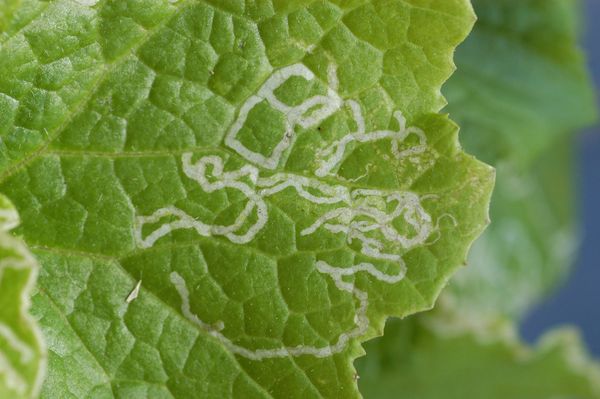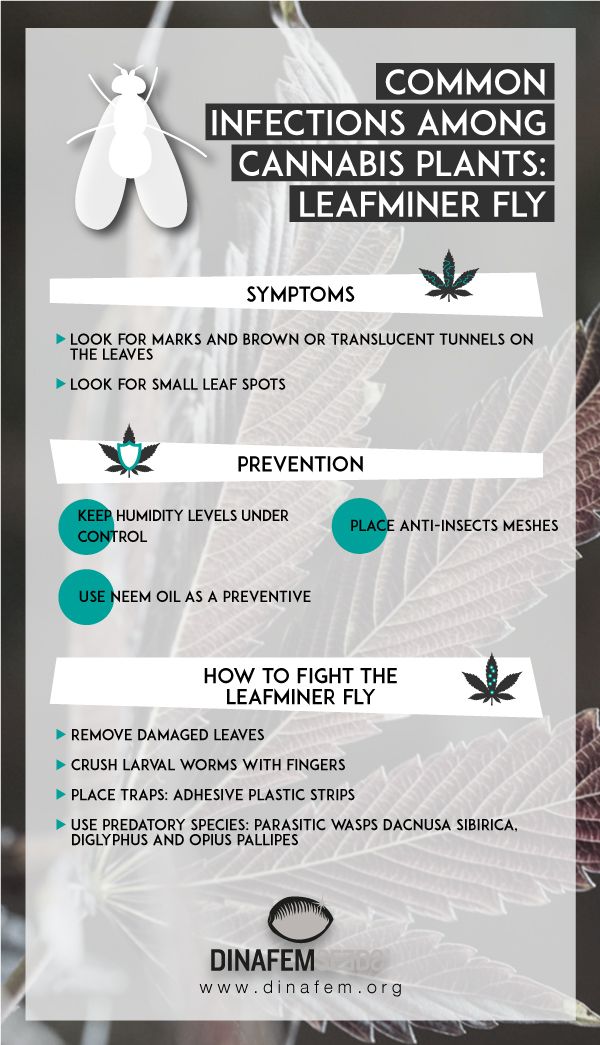- The leafminer (Liriomyza huidobrensis) is one of the plagues that you can eventually suffer if you practice self-cultivation of cannabis, especially outdoor or in greenhouses. This is because, although it is not impossible, it is rare for this insect to show up in indoor crops.
- It is not the most deadly pest and it can rarely destroy the plant completely, but this annoying guest can hamper the proper development of the plant functions and significantly impair your harvest.

To prevent this from happening, pay close attention and keep reading because we will explain everything you need to know about this pest.
How to identify the leafminer?
The leafminer is an insect of the family of the Agromyzidae, and during its life cycle it goes through several stages:
- Egg: They have an average size of 0.25 mm and therefore it will be virtually impossible for you to detect them in your cannabis plants. In addition, they are inserted into the leave tissue, making it even more difficult to identify them.
- Larva: It is in this phase when the leafminer really damages the cannabis plants, as the eggs located inside the leaves hatch, resulting in small larves that grow while feeding themselves and tunneling inside the leaf. These tunnels are visible to the human eye.
- Pupa: Once the larva has already developed and nurtured enough to complete this stage, it breaks the leaf and drops to the substrate. There, it buries itself about an inch to create the pupa, inside which the metamorphosis will take place. However, they can also do so on the surface or on the undersides of the leaves.
- Adult: The leafminer emerges from the pupa turned into a small winged insect of approximately 2 mm.
To identify a leafminer pest in your plant, you must look at the surface of the leaves. The damage produced by the leafminer larvae can be easily identified: brownish or translucent tunnels appear on the leaves indicating that this pest has installed itself in your crop. These small tunnels damage the plant and prevent the proper development of its metabolic functions: in their path, the larvae devour part of tissue the plant uses to do photosynthesis. As a result, the leaves go partially or totally dry and the productivity of the plant decreases.
Other signs you should be attentive to are the punctures that the leafminer females make on the leaves. They make them for two reasons, either to feed themselves from the lifeblood of the plant or to lay their eggs inside its leaves.
How to prevent the leafminer?
In indoor cannabis cultivation, it is easier to prevent this plague, because the temperature and humidity are two decisive factors for the development of a leafminer population. High humidity and warm temperatures are ideal conditions for their appearance. If you want to avoid this pest as well as any kind of fungi, we recommend keeping humidity levels under control.
In outdoor cultivation, it becomes much more difficult to avoid the plague, which under the right weather conditions can become a serious problem. Neem oil can be a good ally to prevent leafminer. In case of greenhouse cultivation, placing anti-insect meshes can help prevent the pest from entering the facility.
How to fight leafminer?
Although it is not a fulminant plague, if you notice the presence of leafminer in your plants, you must take action as soon as possible:
- Eliminate damaged leaves and get rid of them
- Once you have identified larval worms, crush them with your fingers. This will not be difficult to perform because they are trapped inside the leaves.
- Set traps: there are plastic, double-sided adhesive strips which are useful to trap adult individuals.
- Use predatory species: contact insecticides are ineffective against this pest, because the larvae are protected inside the leaves. This is why we recommend using natural enemies such as parasitic wasps Dacnusa sibirica, Diglyphus and Opius pallipes.




Comments from our readers
There are no comments yet. Would you like to be the first?
Leave a comment!Did you like this post?
Your opinion about our seeds is very important to us and can help other users a lot (your email address won't be made public).